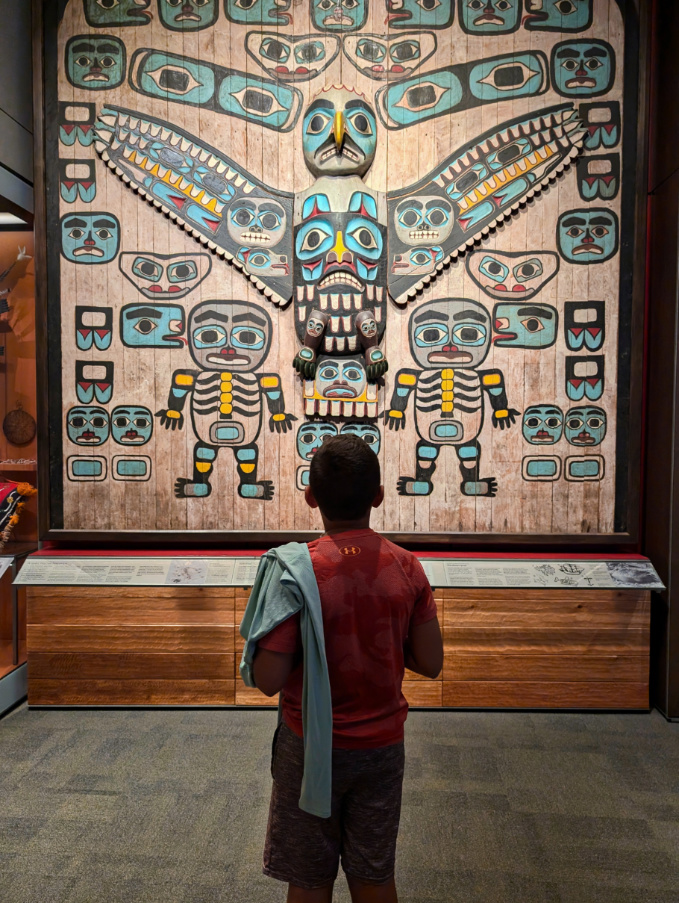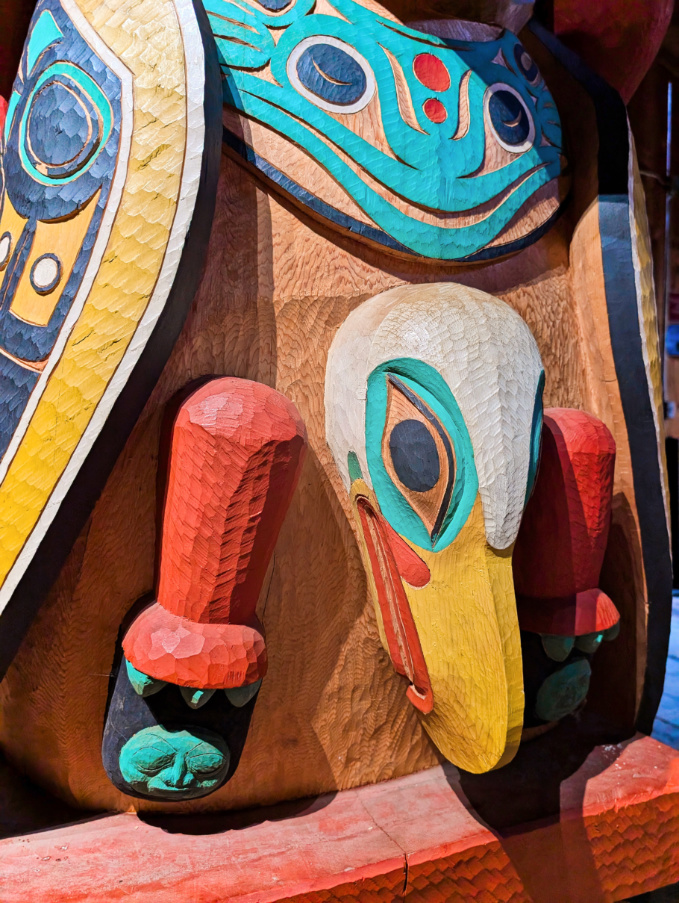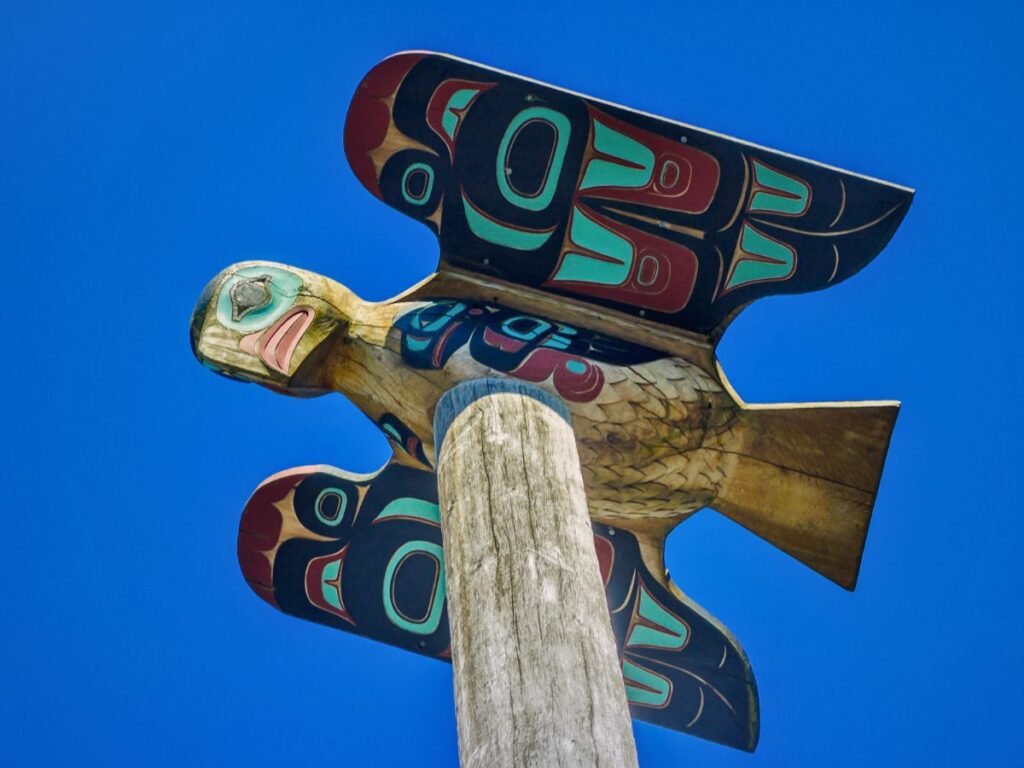When you’re visiting Alaska, you’ll no doubt see lots of indigenous influences, from the names of the towns to the totem poles in front of town hall. Alaska Native culture is very much alive and it’s very diverse. As you plan your Alaska trip, I would encourage you to include activities that bring the Alaska Native culture of the region you’re visiting into your experience. And yes, there is a difference between “Alaska Native” and “native Alaskan.”

What’s the difference between “Alaska Native” and “native Alaskan”?
The difference is simple, although it’s possible to be one and not the other. You can be a native Alaskan and yet not a part of the First People of Alaska.
The term “Alaska Native” refers to the many indigenous peoples whose ancestors held these lands and stewarded them for thousands of years. “Native Alaskan” refers to somebody who was born in Alaska no matter their family background. If you’re the child of a Minnesotan and a Brit but were born in Alaska, you’re a native Alaskan but NOT an Alaska Native. Does that make sense?

Why is it important to understand Alaska Native culture?
Alaska Native peoples live in the cities and towns of Alaska and still maintain many indigenous communities in the Interior, the Aleutian Islands, and throughout Southeast Alaska. Despite efforts during Western Expansion to eliminate the indigenous cultures of North America, including Alaska, the peoples of Alaska have made it through and are actively recovering and enriching their Native cultures.
Many people who grew up in the lower 48 of the USA either didn’t learn about the atrocities of Western Expansion or they’ve been taught to look the other way. Indian Schools were numerous in both the lower 48 AND Alaska, and it was how the US government worked to increase their reach and power over the people. These schools have all been closed now and in many communities they have been turned into museums memorializing the loss of lives and culture relating to expansion, but there are still many people and communities suffering the impacts.
Alaska Native communities still have living members who were not allowed to speak their languages or practice their traditional dances. Alive today. That’s how recent this history is. Today, organizations like the Alaska Native Heritage Center and Alaska Native Language Center (U of A) actively study and share cultural history and practices, and LANGUAGE so that Alaska Natives can take part in their own cultures that their grandparents and great grandparents could not.

Alaska Native Land Acknowledgements
When you go to an event in Alaska, Hawaii or the lower 48 you’ll often hear a Land Acknowledgement at the beginning of whatever you’re participating in. While the act of acknowledging the ancestral lands of wherever you are doesn’t give the lands back or re-enliven the culture and language that was lost, it is a way to show respect to those indigenous peoples who’ve suffered and are actively living to celebrate their ancestry.
Regarding tourism, I think it’s important to include land acknowledgement when encouraging visitors to learn new things and experience activities in Alaska. And with that, here is what I have to say about travel in Alaska and being grateful for the privilege:
We acknowledge that the lands we visit or on which we live here are the traditional lands of the Athabascan, Dena’ina, Tanana, Alutiq, Aleut, Yupik, Inupiaq, Eyak, Tlingit, Haida, Tsimshian and other Peoples that have stewarded this land throughout the generations. We acknowledge the history and current lives of these people and aim to interact with and visit their ancestral lands respectfully and with gratitude.

Alaska Native Tribes and Language Groups
By no means am I the expert on Alaska Native tribes and language groups, but I have loved learning about the many communities and how they vary in dialect, customs, dances and other historical and cultural elements. My grandma was Lakota and didn’t share any of this with us, so getting to learn about the indigenous peoples when we travel has become very important to us, both as travelers and as parents.
When it comes to Alaska Native groups and how they are distributed across the state, both today and historically, it’s fascinating and complex. As you explore on your Alaska trip, you’ll see so many different names: Athabascan, Dena’ina, Tanana, Alutiq, Aleut, Yupik, Inupiaq, Eyak, Tlingit, Haida, Tsimshian and other Peoples. There are actually 229 federally recognized tribes in Alaska. It’s incredible!
To understand a bit better how the different indigenous nations of Alaska are spread out, here is a very general explanation of some of the larger Alaska Native groups:
- Athabascan / Dena’ina / Tanana – Anchorage Area to the Kenai and into Southwest Alaska
- Alutiq – Kenai Peninsula, Kodiak and across Price William Sound
- Aleut – Aleutian Islands
- Yupik – Southwest Alaska to the Norton Sound
- Inupiaq – Arctic Circle including Nome, Prudhoe Bay and Barrow
- Eyak – Cordova and the Gulf of Alaska
- Tlingit / Haida / Tsimshian – Southeast Alaska and Inside Passage

Resources to Learn More about Alaska Native Peoples
Favorite resources for understanding Alaska Native cultures, personal stories and the interface between the US Government and Alaska Native peoples:
- Alaska Native Heritage Center: ALL THINGS relating to living Alaska Native peoples, living culture, historic information and current events – This should always be your first stop when trying to learn about or if you have a question regarding Alaska Native peoples.
- University of Alaska: Alaska Native Language Center – Integral to the survival of native cultures, languages have long been a strength of Alaska Native peoples. This is another great way to gain both insight and understanding for Alaskan heritage.
- National Environmental Education Foundation: Indigenous land acknowledgment information – while land is rarely returned to those from whom it was taken, today one way to show respect to those who came before and who currently steward the land is to openly acknowledge who they are and act in a respectful manner regarding the people, the nature and the land.
- National Park Service: Alaska Native Cultures – resource for archival stories and photos, including modern history and current events
- Bureau of Land Management: Alaska Native Tribes – very simple resource for maps and data
Places to Learn About Alaska Native Culture and History
You can plan an Alaska trip and just see what you might learn as you go OR you can plan stops and activities along your way that are meaning and give context to the sights and cultures you encounter. Something remarkable about traveling in Alaska is the number of opportunities to engage with Alaska Native culture, either in depth or just on the surface. Either way, it’s important to include in your visit and you’ll be so glad you did.
Alaska Native Heritage Center – Anchorage
I love the Alaska Native Heritage Center. This is THE hub of cultural happenings, preservation and awareness. It’s a combination museum and event space. They do classes and immersion for local Alaska Native peoples as well as public events where all are welcome to respectfully observe and participate.
The Alaska Native Heritage Center has art, displays and a gallery/shop for getting a sample of some of the different skills and styles of creations from all around Alaska. Outside you can explore the trail around the lake to visit reconstructed dwellings from the many indigenous tribes of Alaska, including several totem poles and other art. You’ll be able to visit:
- a talking circle
- clan house / long house – Haida / Tlingit / Tsimshian / Eyak
- an Ulax and Ciqlluaq – Alutiiq / Unagax
- a Qargi – Inuqiap / Yupik
- a Qasgiq – Yup’ik / Cup’ik
- a Qenq’u – Athabascan
Each of these is a different sort of dwelling and often when you’re touring the grounds, there are people actively working and doing traditional crafts and skilled work. It’s really cool to see everything in action.

Anchorage Museum – Anchorage
The Anchorage Museum is wonderful for lots of reasons, but I think what really makes it shine are its Alaska Native art installations and the historic regalia and clothing exhibits. The Anchorage Museum is a combination of Alaska history, modern art, historic art and Alaska Native cultural collections. With a kids section and a wide array of subject matter, it’s a great place to visit with any age.

Alaska State Museum – Juneau
I enjoyed each section of the Alaska State Museum. There is a fair amount of Southeast Alaska tribal art and artifacts, as there is a strong Tlingit, Haida and Tsimshian presence to this day in the area. There is also a film exhibit here at the Alaska State Museum that has some fascinating work. We saw a really interesting film about traditional tattoos and their importance in Alaska Native culture today.

Sitka National Historical Park – Sitka
When you picture totem poles and Tlingit culture, you’re probably picturing photos you’ve seen of Sitka National Historical Park. This is one of the coolest places to get to see Tlingit art and practices up close. This is a National Park site, so there are rangers present and lots of staff available for interpretation and information. It’s really beautiful and a very special place to get to visit.

Sealaska Center – Juneau
The Sealaska Center in downtown Juneau is a very active cultural landmark and activity center. With a public plaza for events and performances, outdoor Native Alaska art installations and a wonderful cultural/interpretive center, it’s a great place to visit and is very easy to get to if you’re only in Juneau for a short time via a cruise ship. Inside you’ll find a clan house recreation full of information and art, as well as a shop to purchase all kinds of locally produced carvings, paintings, books, fiber arts and more.
Something very unique about visiting the Sealaska Center is the very current local art on display. Created for local events, competitions and celebrations, there are all kinds of Alaska Native pieces in the exhibition space. You can see beautiful carvings, beadwork, woven pieces telling stories, and even antique pieces along with their stories. I love visiting the Sealaska Center in Juneau.

Totem Heritage Center – Ketchikan
The Totem Heritage Center in Ketchikan is both a museum and cultural site dedicated to preserving and sharing the Alaska Native heritage of the Southeast region, and in particular the art of totem poles and indigenous carving traditions. Established in 1976, it houses a significant collection of 19th-century totem poles retrieved from Tlingit and Haida villages in the area. The Totem Heritage Center focuses on preserving totem poles to prevent further decay and to teach about the intricate craftsmanship, symbolism, and stories behind th
The center also functions as an educational hub, offering carving workshops taught by master carvers, including Native artists, to maintain and pass on traditional carving knowledge. There are exhibits that include not only full and partial totem poles but also tools, masks, regalia, and art from the Tlingit, Haida, and Tsimshian peoples. Visiting the Totem Heritage Center is a meaningful way to engage with Alaska’s Native cultures while learning how Ketchikan has served as an hub for preserving these traditions.

Saxman Native Village – Ketchikan
Saxman Native Village, located just south of Ketchikan, Alaska, is a cultural site that preserves and showcases the heritage of the Tlingit people. Its highlight is the Saxman Totem Park, home to over 25 totem poles, including both original and restored works, each telling stories of clans and legends. Visitors can learn about the art of totem pole carving by observing master carvers at work and exploring the carving shed, where new poles are crafted and old ones restored.
The Beaver Clan House offers immersive cultural experiences, including Tlingit dance performances and storytelling, often inviting visitors to participate. Saxman plays a key role in revitalizing and preserving indigenous traditions through community efforts, educational programs, and tourism. Easily accessible from Ketchikan, the village provides a meaningful opportunity to engage with Native culture and support the continuation of these traditions.

Iñupiat Heritage Center – Utqiaġvik (formerly Barrow)
At the Iñupiat Heritage Center in Utqiaġvik (Barrow), you’ll get a glimpse into the history, traditions and lifestyle of the Iñupiat people. This cozy but meaningful space exhibits everything from traditional clothing, tools, and artwork to exhibits about whaling, which is central to the Iñupiat culture. You can watch videos, see some artifacts and hear personal stories about how the Iñupiat have thrived in the harsh Arctic environment for generations.
Note: many people grew up hearing about “Eskimo” peoples in the Arctic. While that is not the proper name for the Iñupiat people, you’ll still hear it from place to place. When used, the term “Eskimo” tends to include the Inuit people across Canada and Greenland.

I hope you’re excited to experience Alaska Native culture as you explore the state. There are so many wonderful people and vibrant cultures to learn about, I know you’ll love it. If you have any questions about visiting Alaska or how you can including Alaska Native-focused activities in your trip, please leave a comment or send us a note. We’re always happy to help with travel planning for an Alaska Trip!




Pingback: The Anchorage Museum: Beautiful Art and Alaska Native Culture
Pingback: Sealaska Heritage Institute: a Great Tlingit Art and Culture Experience in Juneau
Pingback: AK History and Alaska Native Culture at the Alaska State Museum, Juneau
Pingback: 3 Day Juneau Itinerary - Beautiful Sights and Alaska Native Culture
Pingback: Denali National Park Off-trail Hiking through the Beautiful Tundra
Pingback: Kenai Fjords National Park: Everything You Need to Know (and some things you don't) - My Alaska Trip
Pingback: 2 Week Alaska Road Trip: Homer to Fairbanks and So Much More - My Alaska Trip
Pingback: Two Week Alaska Road Trip: Homer to Fairbanks and So Much More - My Alaska Trip
Pingback: Two Week Alaska Road Trip: Homer to Fairbanks and Much More